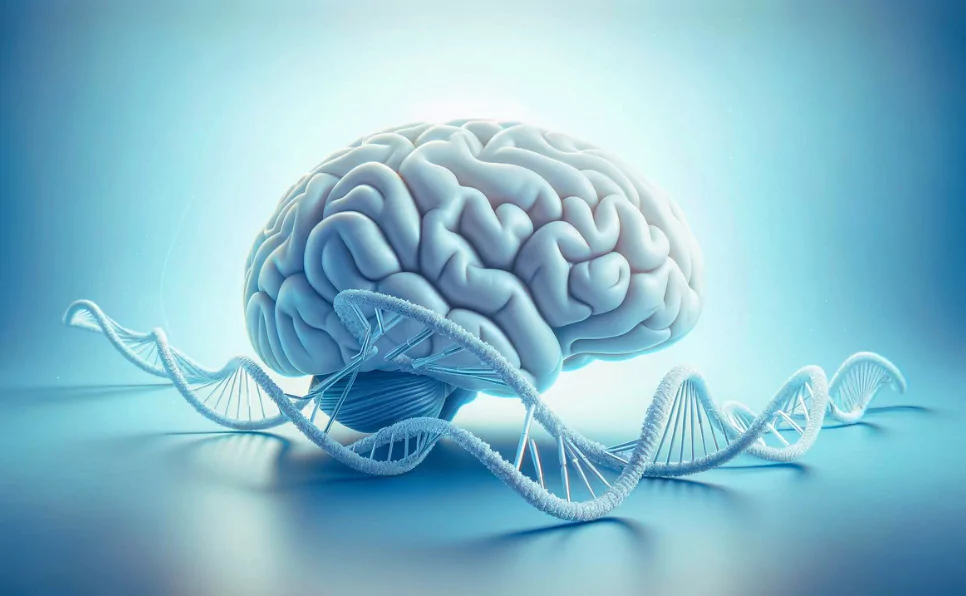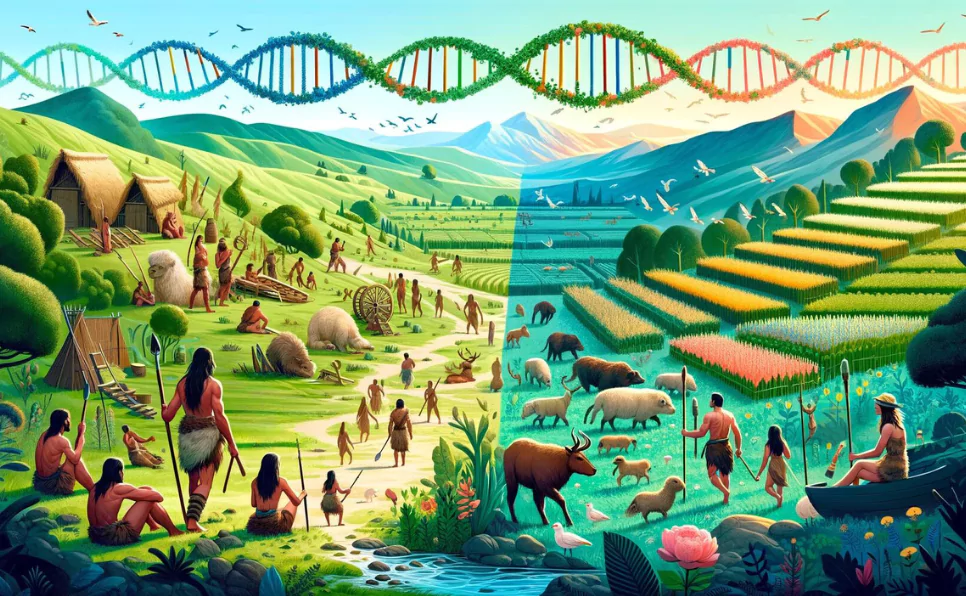When we talk about what sets us apart from other animals, the human brain tops the list.
It’s not just about size; it’s about the capacity for language, problem-solving, creativity, and empathy.
Understanding how our brains evolved over millions of years isn’t just a journey into the past; it’s a quest to understand ourselves.
And guess what? Our genes played a starring role in this epic story.
In this article, we will dig deep into the genetic basis of human brain evolution.
Key Takeaways
- The evolution of the human brain is a complex process influenced by multiple genetic factors.
- Specific genes and regulatory mechanisms have played pivotal roles in the development of unique human cognitive abilities.
- Genetic mutations and natural selection have driven the increase in brain size and complexity.
Understanding Brain Evolution
The Human Brain vs. Other Species
The human brain is a marvel, a complex organ that’s more capable than any computer you know. But what makes it so special compared to other species?
- Size and complexity differences: Sure, there are larger animals. But when you compare brain size relative to body size, humans come out on top. Our brains have about 86 billion neurons, way more than other animals. This isn’t just a numbers game; it’s about the connections these neurons can make, creating a network of unparalleled complexity.
- Cognitive abilities unique to humans: We’re talking about advanced tools, language, self-awareness, and cultures. These aren’t just fancy extras; they’re fundamental to what it means to be human. Animals show signs of intelligence and problem-solving, but humans have taken it to another level.
“Our brains didn’t just grow; they evolved to do things no other species can.”
Key Milestones in Human Evolution
Human brain evolution wasn’t an overnight success story. It was a series of upgrades over millions of years, each adding something unique to the mix.
Starting with Australopithecus, our early ancestors who walked the African savannahs over 4 million years ago, to the emergence of Homo sapiens roughly 300,000 years ago, each step in this timeline marks a critical point in our evolutionary journey.
What’s fascinating is how our brain size and capabilities expanded over this time. For example, the brain volume of Homo habilis, an early human species from about 2 million years ago, was about 600 cubic centimeters, which then ballooned to about 1400 cubic centimeters in modern humans.
Comparative brain sizes and capabilities This increase in brain size correlates with advanced cognitive abilities, such as improved problem-solving, language, and the development of complex societies.
But it’s not just the size that matters; the structure of the brain evolved to be more complex, enabling more sophisticated thought processes.
Here is estimated timeline.
- Australopithecus to Homo habilis: This is where the journey kicks off, around 2-3 million years ago. Early humans like Homo habilis started using tools, showing that our brains were already on a different path.
- Homo erectus: Jump forward to about 1.8 million years ago, and we meet Homo erectus. These guys took things global, spreading out of Africa. Their brains were larger, and they used more complex tools. Cooking food likely played a big part here, making nutrients more accessible and supporting brain growth.
- Neanderthals and Denisovans: Here’s where it gets interesting. Neanderthals and Denisovans weren’t just offshoots; they were part of the family. Interbreeding between these groups and early modern humans around 40,000 years ago added genetic diversity, affecting everything from our immune system to our brains.
- Modern humans: The last piece of the puzzle. Our brains didn’t just get bigger; they got better at processing information, planning, and creating complex societies.
Throughout these stages, one thing is clear: brain evolution wasn’t just about size. It was about structure, functionality, and, most importantly, the genetic changes that made all this possible.
Our ancestors weren’t just surviving; they were adapting, learning, and innovating.
Genetic Foundations of Brain Development
When we talk about our brains, we’re not just talking about an organ but a complex masterpiece that has become more complex, more capable. And at the heart of this story? Our genes.
Crucial Genes Involved in Brain Evolution
Genes specific to humans (e.g., HARs, FOXP2):
Some genes really set us apart from the rest of the animal kingdom. Human Accelerated Regions (HARs) are a perfect example.
These are segments of our DNA that have changed rapidly since our lineage diverged from that of our closest relatives, the chimpanzees.
Then there’s FOXP2, often dubbed the “language gene” because of its ties to speech and language development.
It’s not that other animals don’t have FOXP2, they do – but our version has specific mutations that are believed to play a key role in our unique capacity for language.
FOXP2 isn’t just about making sounds; it’s about the capacity for complex, nuanced communication.
Other specific genes (e.g., HAR1, ASPM, MCPH1) have been linked to brain size and structure, showing how genetic mutations can have a profound effect on our development.
For instance, the ASPM gene, when mutated, is associated with microcephaly, a condition where the brain size is significantly smaller than normal.
Role of gene duplication and divergence:
Evolution loves to reuse and repurpose.
Gene duplication, where an organism ends up with copies of a gene, has been a major player in brain evolution.
These extra copies can take on new functions over time.
This process of divergence has given us a toolbox full of genetic material that has been tinkered with and tailored, leading to the sophisticated organ that sits between our ears today.
“Evolution doesn’t create from scratch; it builds on what’s already there.”
Regulatory Networks and Gene Expression
- Importance of gene regulation in development: Genes are like individual musicians in an orchestra; it’s not just about who’s playing, but how and when they play. Gene regulation is the conductor, ensuring that genes are expressed at the right time, in the right place, and in the right amount. This precision is crucial during brain development, where the timing and coordination of gene expression guide the formation of complex structures and networks.
- Epigenetics and brain plasticity: Here’s where it gets really interesting. Our genetic code isn’t just a static blueprint. Epigenetics involves changes in how genes are expressed, without altering the underlying DNA sequence. These changes can be influenced by our environment, experiences, and even our behaviors. Brain plasticity, the ability of the brain to change and adapt, is deeply tied to epigenetic mechanisms. It’s a dynamic process, allowing for the fine-tuning of brain functions in response to our interactions with the world.
Evolutionary Adaptations and Changes
Natural Selection and Brain Size
- Relationship between survival and cognitive ability: It’s no secret that our big brains have given us a leg up in the survival stakes. The ability to solve complex problems, plan for the future, and communicate effectively has been crucial. There’s a clear correlation between brain size and cognitive ability, but it’s important to remember that bigger doesn’t always mean smarter. It’s about the efficiency and connectivity of the brain’s networks.
- Impact of environmental changes on brain evolution: Our ancestors faced a world that was constantly changing. Those who could adapt, thrived. Environmental pressures have shaped our brains, pushing for advancements in social skills, problem-solving abilities, and adaptability. Climate shifts, the transition to bipedalism, and changes in diet, all of these factors have nudged our brains along the evolutionary path.
Genetic Mutations and Their Effects
Beneficial mutations that impacted brain development: Mutation is often painted as the villain, but it’s also a hero of evolution.
Small changes in DNA have had massive impacts on our brain’s development.
Some mutations have led to increased brain size, others to enhanced connectivity between brain regions.
It’s a bit like tweaking the code in a complex software; even small changes can lead to new and unexpected features.
“Beneficial mutations are nature’s way of experimenting with new traits.”
Case studies: HARs (Human Accelerated Regions) and their impact One of the most striking discoveries in this field has been the identification of Human Accelerated Regions (HARs).
These are segments of our DNA that have evolved rapidly in humans compared to other species.
HARs are believed to play crucial roles in brain development and cognitive function.
For instance, HAR1 is highly active in the brain during fetal development and shows significant changes from our closest evolutionary relatives, suggesting a key role in the development of human brain features.
Modern Human Brain: Evolutionary Perspectives
When we look back at the path of evolution, it’s clear that the journey from our ancient ancestors to modern humans has been long and filled with significant changes.
The genetic adaptations that have occurred over millions of years are not just chapters of our past; they directly influence who we are today.
- How ancient genetic adaptations influence us today: It’s fascinating to think that the genetic changes which helped our ancestors survive and thrive in their environment also play a crucial role in our lives today. For instance, the development of our cognitive abilities, such as problem-solving and language, can be traced back to these genetic adaptations. These abilities have allowed humans to create complex societies and innovative technologies.
- The debate on recent evolutionary changes in humans: Some scientists argue that human evolution has slowed down or even stopped because technology and society shield us from natural selection. Others believe evolution continues but at a pace so slow we can’t easily see it. A compelling point here is that our environment is changing faster than ever before, possibly driving evolution in new directions, especially in areas like disease resistance or dietary adaptations.
Implications for Understanding Human Behavior
Understanding the genetic basis of brain evolution has real-world implications, especially when it comes to understanding human behavior, including the underpinnings of neurological and psychiatric conditions.
- Insights into neurological and psychiatric conditions: By tracing back the genetic changes that shaped our brain, scientists can better understand the origins of various conditions, such as autism, schizophrenia, and bipolar disorder. This knowledge is crucial for developing more effective treatments.
- Genetic basis of learning, memory, and creativity: Our capacity for learning, the way we form memories, and our creative talents are all deeply rooted in our genetics. Recent studies have started to unravel genes associated with these abilities, offering insights into how we can nurture and enhance these traits in individuals.
“Our genes are not just our history book; they’re the manual for current and future human potential.”
Final Thoughts
The journey through the genetic basis of human brain evolution offers more than just a glimpse into our past. It holds keys to understanding our present and shaping our future.
The insights gained from studying our evolutionary history help us grasp the complexity of the human brain, uncover the roots of neurological and psychiatric conditions, and even hint at ways to enhance learning, memory, and creativity.
The knowledge of our genetic evolution is not just a story of where we’ve come from; it’s a guide to where we could go. The future of human potential lies in unlocking the secrets held within our DNA, a task that researchers are more equipped for now than ever before.
FAQs
What is the significance of the FOXP2 gene in human evolution?
The FOXP2 gene is often called the “language gene” because it’s crucial for speech and language development. Changes in this gene about 200,000 years ago helped humans develop complex language skills, setting us apart from other primates. It represents a key moment in human evolution, enabling communication and social organization.
How do geneticists identify genes that have contributed to brain evolution?
Geneticists use a combination of fossil records, comparative genomics, and modern DNA sequencing technologies to identify genes involved in brain evolution. By comparing human genomes with those of other species, scientists pinpoint genetic differences that could explain our unique cognitive abilities. Advances in technology have greatly accelerated this process.
Are there any genetic links to the cognitive abilities that distinguish humans from other primates?
Yes, several genes have been identified as key players in the cognitive leap between humans and other primates. For example, genes related to neural development, synaptic formation, and brain size, such as ASPM and HAR1, have undergone significant changes in humans, linking directly to our advanced cognitive abilities.
How does understanding the genetic basis of brain evolution impact modern medicine?
Understanding the genetic basis of brain evolution provides insights into the roots of neurological and psychiatric conditions, guiding the development of targeted treatments. It helps medical professionals understand the biological underpinnings of these conditions, leading to better diagnostics, treatments, and, ultimately, preventive strategies.
Can genetic studies suggest why humans developed such advanced language and social structures?
Genetic studies indicate that mutations and natural selection of certain genes, like FOXP2, played a significant role in developing advanced language and social structures in humans. These genetic changes facilitated complex communication and cooperation, which are the foundations of social structures and culture.
Is there ongoing evolution in the human brain at a genetic level today?
Yes, there is evidence to suggest that the human brain is still evolving at a genetic level. Changes in our environment, lifestyle, and society continue to exert selective pressures that could lead to genetic adaptations. However, these changes occur over many generations and are challenging to observe in real time.
How do environmental factors interact with genetics in the context of brain development and evolution?
Environmental factors and genetics interact dynamically in brain development and evolution. Environmental pressures can influence which genetic variations are advantageous, leading to evolutionary changes. For example, changes in diet, climate, and social structures can all impact which genetic traits are selected for or against in populations, influencing brain development over time.
For Further Reading
- Evolution of cortical neurogenesis in amniotes controlled by Robo signaling levels – Cell
- Evolution of the neocortex: a perspective from developmental biology – Nature Reviews Neuroscience
- Subcortical origins of human and monkey neocortical interneurons – Nature Neuroscience
- Extensive migration of young neurons into the infant human frontal lobe – Science
- The genetic symphony underlying evolution of the brain’s prefrontal cortex – Nature
- Genetic links between brain development and brain evolution – Nature Reviews Genetics
- Genetic architecture of human brain evolution – Current Opinion in Neurobiology

Dr. Heena Arora, a passionate geneticist and microbiologist, is a valuable asset to the Genes Wellness team. Her seminal work includes identifying a key gene for white rust resistance in mustard. Leveraging her deep expertise in genetics and microbiology, she ensures the accuracy and integrity of our content. Dr. Heena’s commitment to knowledge dissemination makes her an integral part of our team.





